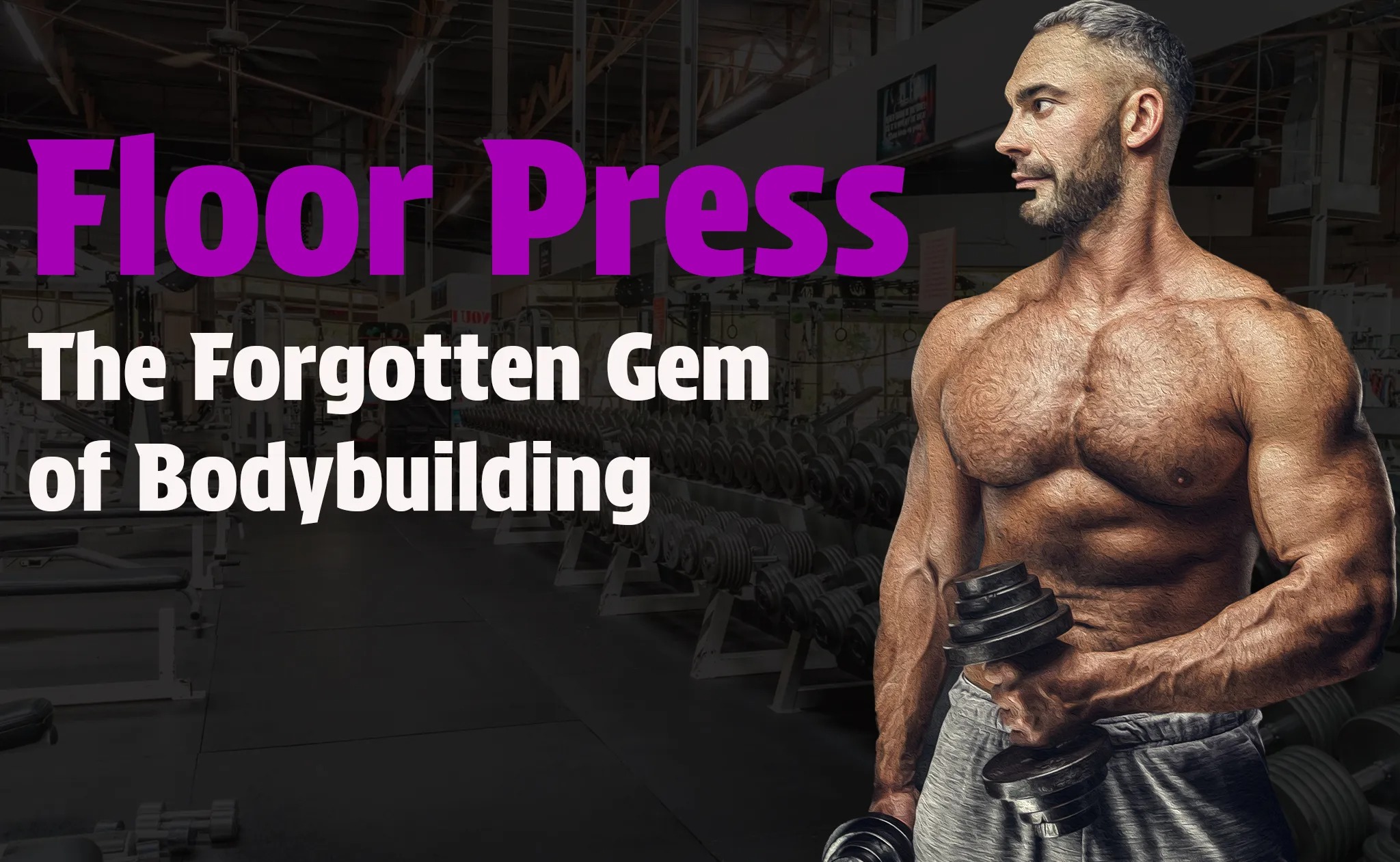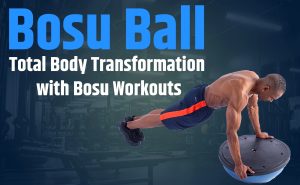The floor press may not be as glamorous or well-known as the bench press, but it packs a punch when it comes to targeting your upper body muscles. By lying on the floor (no bench and rack required) and pressing the weight up, you’re able to engage your chest, shoulders, and triceps in a unique and challenging way. It’s a fantastic exercise for building strength and adding size to your upper body, yet it often goes unnoticed by many gym-goers.
Introduction to Floor Press
The floor press is a powerful exercise that targets your upper body muscles in unique and challenging ways. It involves lying on the floor and pressing the weight up, engaging your chest, shoulders, and triceps. Unlike the bench press, the floor press removes the leg drive from the equation, making it a more pure upper body exercise.
Floor Press Exercise: History and Origins
Originally popularized by strongmen and bodybuilders in the early 20th century, the floor press quickly became a staple exercise for building upper body strength. Back then, athletes didn’t have access to fancy gym equipment, so they had to get creative with their workouts. The floor press allowed them to develop impressive pressing strength without the need for a bench.
Over time, the floor press took a backseat to the more mainstream bench press. Gym-goers became enamored with the idea of lifting heavy weights on a bench, and the floor press slowly faded from the spotlight. However, it’s time to bring this exercise back into the limelight and reap its many benefits.
Floor Chest Press: Floor Press Variations
This underrated exercise provides a stimulating and challenging workout for your upper body muscles, without the need for a bench. If you’re tired of the same old routine and have a limited space or sources, it’s time to give the floor press a try.
Barbell Floor Press: A Powerhouse for Upper Body Strength
When it comes to the floor press, the barbell variation is a force to be reckoned with. Using a barbell allows you to load up the weight and challenge yourself to push your limits.
- Start by lying on the floor with your legs up (glute bridge position)
- Use a shoulder-width grip on the barbell, tuck your shoulder blades in – this will serve as the arch in bench press
- Position the bar on your pelvis, make sure you are comfortable with the position of the bar
- Push the weight up with your pelvis, keeping your hips up until you reach the chest press position.
- Slowly lower your hips as you transfer the weight in your elbows. As soon as your glutes hit the ground, press the weight up.
- Engage your chest, shoulders and triceps as you press up
- Keep your elbows tucked as you continue to push the barbell up – this emphasizes the triceps and helps to build impressive pressing strength.
After completing a floor press, returning to the starting position is a key component of the exercise. Here’s a simple guide on how to transition smoothly and effectively:
- First, ensure that you have control over the weight you’re using.
- Slowly set your elbows back to the floor
- Push your hips up and transfer the weight into your pelvis
- Slowly lower your hips to floor until the plates hit the ground.
Dumbbell Floor Press: Unleash the Power of Unilateral Training
If you’re looking to switch things up and work each side of your body individually, the dumbbell floor press is a fantastic option. By using dumbbells instead of a barbell, you challenge each arm independently, forcing your muscles to stabilize and work harder to maintain control.
- Dumbbell Floor press can iron out any muscular imbalances and improve overall strength.
- It also allows a greater range of motion – provides a deep stretch at the bottom and a powerful contraction at the top.
Floor Bench Press: Building Super Strength and Muscles Targeted
When it comes to building super strength, the floor press is an exercise that shouldn’t be overlooked. It may seem simple, but it packs a powerful punch by targeting specific muscles in the upper body.
Primary Muscles Targeted: Chest and Triceps
- The floor press primarily targets the muscles in your chest, specifically the pectoralis major and minor. As you press the weight away from your body, these muscles contract to generate the force needed to lift the load.
- Additionally, the triceps are heavily engaged during the floor press. As you press the weight away from your body, the triceps work in conjunction with the chest muscles to provide the necessary strength for the movement.
Secondary Muscles Engaged: Shoulders and Upper Back
- The shoulders, particularly the anterior deltoids, assist in stabilizing the movement and controlling the descent of the weight.
- Additionally, the upper back muscles, such as the rhomboids and trapezius, help maintain proper posture and stability during the exercise.
Tweaks to Target Different Chest Muscles
Experiment with different hand positions to target specific areas of your chest and maximize your gains from the floor press.
- Placing your hands closer together will emphasize the use of the triceps and inner chest muscles.
- On the other hand, widening your grip will shift the focus to the outer chest muscles.
Floor Press vs. Bench Press
When it comes to upper body exercises, the bench press is often seen as the gold standard. It’s a classic move that targets the chest, shoulders, and triceps, and is a staple in many strength training routines. However, have you ever considered incorporating the floor press into your workout instead?
Floor Press: Benchless Way to Challenge your Muscles
Unlike the bench press, the floor press is performed by lying on the floor instead of a bench.
- Great for gyms with limited space and resources.
- Creates a shortened range of motion, which can be beneficial for individuals with shoulder issues or limited mobility
- Eliminates the stretch at the bottom, which allows you to focus on the pressing portion, engaging your muscles and building strength.
- Also eliminates leg drive. By eliminating the leg drive, which is often used in the bench press, the floor press challenges your upper body muscles without assistance from the lower body. This allows you to gauge and work on your pure upper body strength, revealing any imbalances and weaknesses that need attention.
Bench Press: The Classic Move for Building Upper Body Power
On the other hand, the bench press is a tried and true exercise that has been a go-to for bodybuilders and powerlifters for decades.
- It allows for a greater range of motion, targeting the chest, shoulders, and triceps in a dynamic way.
- By pressing the weight from the chest to full extension, you work the muscles through a full range of motion and develop overall upper body power.
Bench Press Alternative: Why Everyone Should Try Floor Press

Explore why you should incorporate the floor press into your fitness routine and highlight its advantages over bench press.
- Enhanced Stability and Safety
When you lie on the floor, your body is supported, and you have a solid base to press from. This stability translates into better control and reduces the risk of injury.
- Shoulder-Friendly Movement
Unlike exercises like the bench press that require a significant range of motion, the floor press limits how far you can lower the weight. This reduced range of motion is particularly beneficial for individuals with shoulder issues or limited mobility. By avoiding extreme shoulder extension, the floor press puts less stress on the shoulder joint, making it a safer and more shoulder-friendly pressing option.
- Transferability to Real-Life Movements
The pressing motion you perform during the floor press mirrors common actions such as pushing a heavy object, getting up from the ground, or even performing sports-related movements. By training these functional movements, you can improve your performance in daily activities, reduce the risk of injuries, and enhance your overall quality of life.
- Saves Time
Unlike exercises like the bench press that require a spotter or safety pins, the floor press allows you to work out independently. This eliminates the time spent waiting for a spotter or setting up the equipment, enabling you to make the most of your time in the gym.
Additionally, the floor press eliminates the need to adjust the bench height or set up additional equipment.
This time-saving aspect makes the floor press a convenient option for individuals with busy schedules or those who prefer to have shorter, more intense workouts.
- Saves Space
With the floor as your workout surface, you don’t need a bulky bench that occupies a significant amount of space in your home or gym. This is particularly beneficial if you have limited workout space or if you prefer to exercise in a compact area.
Avoiding Common Mistakes in Floor Press
The floor press is an effective exercise that can offer great benefits, but like any exercise, it’s important to perform it correctly to maximize its effectiveness.
Improper Elbow Positioning
One of the common mistakes people make during the floor press is improper positioning of the elbows.
- It’s crucial to maintain a proper 45-degree angle with your elbows as you lower the weight.
- Avoid to flare your elbows out to the sides, which puts unnecessary strain on the shoulders.
- To avoid this, focus on keeping your elbows tucked in and close to your body throughout the movement.
Limited Range of Motion
Another mistake to watch out for is limiting your range of motion during the floor press.
- Some individuals tend to only perform partial reps, not allowing the weight to touch the floor. This restricted range of motion hinders the overall effectiveness of the exercise.
- To avoid this, make sure to lower the weight until your elbows gently touch the floor. This full range of motion engages more muscle fibers and promotes better overall strength and muscle development.
Floor Press Program: Barbell Bench Press Alternative
If you don’t have access to a bench or simply prefer training without one, the floor press is an excellent exercise to include in your routine. Here is a sample workout program that incorporates floor press exercises and explain how to integrate it into your existing training routine, all without the need for a bench.
Sample workout program
Remember to adjust the weight used, number of sets, and repetitions depending on your goals and progress. You can increase the challenge by gradually increasing the weight lifted, improving your form, or performing more sets and reps over time.
- Day 1:
- Floor press: 3 sets x 8 reps
- Push-ups: 3 sets x max reps
- Bent-over rows: 3 sets x 8 reps
- Tricep dips: 3 sets x 12 reps
- Day 2:
- Deadlifts: 3 sets x 8 reps
- Pull-ups (or assisted pull-ups): 3 sets x 8 reps
- Dumbbell curls: 3 sets x 12 reps
- Romanian Deadlifts: 3 sets x 12 reps
- Rear delt flyes (with dumbbells): 3 sets x 12 reps
- Day 3:
- Floor press: 4 sets x 6 reps
- Pike push-ups: 3 sets x max reps
- Close-grip push-ups: 3 sets x 12 reps
- Hammer curls: 3 sets x 12 reps
- Day 4:
- Overhead Press: 3 sets x 8 reps
- Hip Thrusts: 3 sets x 12 reps
- Bent-over rows: 3 x 8 reps
- Split-Squats: 3 x 6 reps
Nutritional Support for Floor Press
In order to get the most out of your floor press workouts, it’s important to provide your body with the right nutritional support. Proper nutrition plays a vital role in fueling your workouts, aiding in muscle recovery, and supporting overall strength and performance.
Protein
- Make sure to consume an adequate amount of protein.
- Include protein-rich foods such as lean meats, poultry, fish, eggs, and plant-based sources like beans and tofu in your diet.
- Aim to spread your protein intake evenly throughout the day to support muscle regeneration after your floor press sessions.
Carbohydrates
- Provide the necessary fuel to power through intense workouts.
- Include complex carbohydrates like whole grains, fruits, and vegetables in your meals and snacks.
- These carbohydrate sources provide sustained energy and are rich in vitamins and minerals that support overall health and wellbeing.
Hydration
- Staying properly hydrated is essential for optimal performance and recovery.
- Water helps transport nutrients to your muscles, lubricates your joints, and regulates body temperature.
- Make sure to drink enough water throughout the day, especially before, during, and after your floor press workouts.




